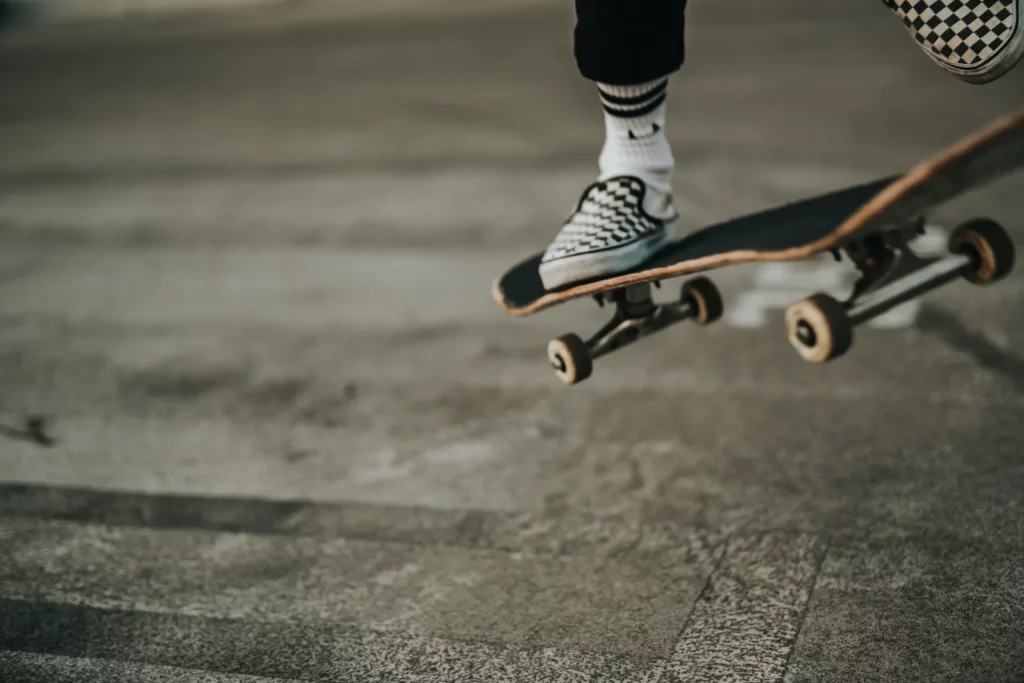Skateboarding and running are two popular forms of exercise that offer a variety of benefits for the body and mind. Both workouts require physical effort, can improve muscle tone, and help to keep the cardiovascular system in top shape. However, when it comes to which form of exercise is better overall – skateboarding or running – there isn’t necessarily a clear winner.
One benefit of skateboarding over running is that it engages more muscles throughout the body. Skateboarding requires balance and coordination, meaning that riders must activate their core muscles and legs, and arms. Additionally, skateboarding involves jumping and twisting movements that work for several different muscle groups at once. On the other hand, running primarily focuses on leg muscles with only moderate activation of core muscles.
However, one downside of skateboarding is that it can be more challenging to maintain proper form than running.
Does running burn more calories than skating?
Regarding calorie burn, both running and skating are great choices for weight loss. However, the number of calories burned will depend on several factors, like intensity, duration, and body weight. Running at a moderate pace for an hour can burn approximately 350-500 calories, depending on the individual’s weight. On the other hand, skating at a moderate pace for an hour can burn about 300-450 calories.

One significant benefit of running is that it is a high-intensity workout that elevates heart rate, which benefits cardiovascular health. While skating does not elevate heart rate as much as running, it still requires balance and coordination that engages core muscles. Additionally, skating may be more low-impact than running, which can strain joints over time.
is skateboarding faster than running
Skateboarding involves riding on a board with wheels while performing tricks. In contrast, running is a form of locomotion where you move your body by repeatedly lifting and setting down one foot after another. In terms of speed, skateboarding can be faster than running if done correctly. Skaters can gain momentum and speed by utilizing gravity to their advantage while going downhill or performing tricks like the ollie or kickflip.
However, it’s important to note that skateboarding is sometimes slower than running, especially in long distances or uphill climbs. Running also helps improve cardiovascular health and endurance, which can also help skaters when they need to perform for extended periods without getting tired quickly.
At the end of the day, whether skating or running is better depends on an individual’s interests and goals. Both activities offer unique benefits that can help in various aspects of life, such as boosting mental health, strengthening muscles, and improving coordination skills, among others. Ultimately, it’s up to each person to decide which activity best suits their lifestyle and preferences based on what they want to achieve from doing them.
Is Skateboarding A Good Cardio Than Running?
Skateboarding and running are great cardio forms, but which one is better? Skateboarding can be just as effective as running for cardiovascular exercise. However, safety should be a top priority when skateboarding, so it’s essential to wear a helmet and other protective gear. Skateboarding involves more upper-body movement and coordination than running, making it a full-body workout.

Another advantage of skateboarding is the amount of kinetic energy involved. When performing tricks or going downhill, skateboarders generate more speed and force than runners do. This increased energy expenditure means that skateboarding burns more calories per minute than running does. Additionally, the varied terrain of skateparks provides an opportunity for different muscle groups to be engaged throughout the workout session.
Why skateboarding better than running?
Skateboarding involves constant movement, which can help improve your cardiovascular health and overall fitness levels. Additionally, skateboarding engages multiple muscle groups throughout the body, including your glutes. The constant movement required in skateboarding can help tone and strengthen these muscles over time.
Unlike running, skateboarding also provides the opportunity for creativity and self-expression through tricks and maneuvers. This adds an extra level of enjoyment to the activity, making it easier to stick with as part of a regular exercise routine. Plus, since skating is low-impact compared to running, it’s also less likely to cause injuries such as shin splints or knee pain.
Do skateboarding and running use the same sort of muscles?
Skateboarding and running may seem entirely different, but they utilize some of the same muscle groups. Both sports require a great deal of leg strength and endurance. Skateboarding, for instance, demands a lot of control over the board while performing tricks that engage muscles throughout the body.
In contrast, running is considered a full-body workout because it involves almost all major muscle groups. Running shoes are designed to provide comfort and support for the feet during these high-impact workouts. The repetitive running motion can stress joints and muscles if proper form is not maintained.
The answer to whether skateboarding is better than running ultimately depends on one’s goals and preferences. Both sports offer unique benefits, such as improving cardiovascular health or building muscle strength. It’s essential to choose an activity that you enjoy doing consistently so that it becomes part of your lifestyle rather than just another chore on your list.
Benefits of Skateboarding
A Fun Way to Get Fit
Skateboarding is a great way to get a workout while having a blast. Whether you’re performing tricks at the skate park, cruising down the street, or grinding on a rail, skateboarding is an engaging and thrilling sport. Not only does skateboarding help improve your balance and coordination, but it also works your core muscles, glutes, hamstrings, and lower back. Additionally, skateboarding may help you burn more calories than running, depending on the intensity of your session.
Low-Impact Exercise
Compared to running, skateboarding is a lower-impact form of exercise, meaning it’s gentler on your joints, including your knees, ankles, and lower back. While running can cause injuries to these areas due to the repetitive impact of hitting the ground, skateboarding offers a smoother ride on its wheels, reducing the risk of damage to your joints.
Improved Coordination and Dexterity
Skateboarding is a great exercise for improving balance, coordination, and agility. Maneuvering your skateboard, performing tricks, and mastering different terrain types require skill and finesse. As you become more agile and learn to maneuver your skateboard with ease, you’ll also develop better body awareness and control.
An Alternative Mode of Transportation
Skateboarding is also an eco-friendly and enjoyable form of transportation. Instead of driving or taking public transit, consider skateboarding to work, school, or around town for a fun, low-impact workout that also helps reduce your carbon footprint.
Benefits of Running
An Accessible and Straightforward Workout
Running is a simple and accessible form of exercise that can be done almost anywhere. All you need is a pair of running shoes and an open surface to get started. Running is an effective form of cardiovascular exercise, which helps strengthen your heart and lungs, burn calories, and improve overall fitness.
Calorie Burning and Weight Loss
Running and skateboarding can both help you lose weight by burning calories. The number of calories burned per minute will vary depending on your weight, speed, and intensity. However, running often burns more calories than skateboarding due to the consistent aerobic nature of the exercise.
The Runner’s High
Many runners swear by the “runner’s high” – the feeling of euphoria and reduced stress that often follows a long or intense run. This sensation is caused by the release of endorphins in the brain and can make running an enjoyable and therapeutic experience for many.
Strengthening Your Lower Body Muscles
Running primarily targets your lower body muscles, such as the quadriceps, hamstrings, glutes, and calves. As a weight-bearing exercise, running helps strengthen these muscles and promotes bone health.
Comparing Skateboarding and Running
Injury Risk
Both skateboarding and running come with their own set of injury risks. Skateboarding injuries are often the result of falls, which can lead to cuts, bruises, or fractures. On the other hand, running injuries are typically caused by overuse and repetitive stress on joints, tendons, and muscles.
Cardiovascular Benefits
When it comes to cardiovascular exercise, running Generally has the advantage over skateboarding. While skateboarding can provide a moderate cardio workout, running consistently raises your heart rate and provides a more intense aerobic exercise. However, by incorporating high-intensity intervals or challenging tricks into your skateboarding sessions, you can also achieve an effective cardiovascular workout.
Muscle Development
Both skateboarding and running offer unique muscle-strengthening benefits. Running primarily targets the lower body muscles, while skateboarding engages a wider variety of muscles, including the core, lower back, and upper body. If you’re looking for a more well-rounded workout, skateboarding might be the better choice.
Caloric Burn
As mentioned earlier, running tends to burn more calories per minute than skateboarding due to its consistent, aerobic nature. However, if you’re looking to lose weight, both types of exercise can be effective when combined with a healthy diet and lifestyle.
Skill and Learning Curve
Skateboarding has a steeper learning curve compared to running. Mastering the basics of skateboarding, such as balance, pushing, and turning, can take some time and practice. Additionally, learning and perfecting tricks can be a long-term commitment. On the other hand, running is a more straightforward exercise, requiring less skill and technique to get started.
Versatility and Adaptability
Running can be done on various surfaces and terrains, making it a more versatile form of exercise. You can run on a track, treadmill, pavement, or trail, giving you plenty of options for your workouts. Skateboarding is typically limited to smoother surfaces, like concrete, asphalt, or specially designed ramps and skate parks.
Making the Right Choice for Your Fitness Journey
When deciding between skateboarding or running, consider your personal preferences, goals, and lifestyle. Skateboarding might be the right choice if you enjoy learning new tricks, crave variety in your workouts, and want to improve your balance and coordination.
On the other hand, if you prefer a more straightforward, accessible form of exercise that offers cardiovascular benefits and a higher calorie burn, running could be your ideal workout.
Ultimately, the best form of exercise is one that you enjoy and can stick to in the long run. Feel free to experiment and try skateboarding and running to find the best fit for you. Remember that incorporating a mix of different exercise types can provide a well-rounded workout routine and help you stay fit, healthy, and motivated.
Conclusion
Both skateboarding and running are excellent ways to improve your physical fitness and mental well-being. While running has advantages in terms of convenience and accessibility, skateboarding offers a unique blend of creative expression, skill-building, and community bonding. Ultimately, the choice between the two comes down to personal preference, lifestyle, and individual goals.
Whether looking for a fun way to stay active or seeking new challenges to push yourself beyond your limits, skateboarding and running can provide countless benefits. So why not try them out and see which one resonates with you the most? Whether cruising through streets on a skateboard or hitting the pavement for a run, enjoy the journey along the way!

“Welcome to our website, Here You’ll find a wealth of information on finding the right skating gear that will last for years to come, as well as tips and tricks to help you improve your skills. Whether you’re a beginner or an experienced skater, you’ll find something of value here.”



